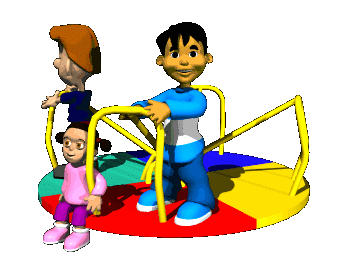Uniform Circular Motion
Objectives
- Introduce students to concepts and quantities of uniform circular motion.
- Utilize graphical analysis to determine an unknown quantity.
Procedure
Part I - Constant Radius
- Print out the lab handout.
- Reset the program by clicking the <Reset> button in the bottom of the control window.
- Set radius to 2m, and adjust the <Rotational Speed> slider until you obtain an angular speed of 0.3 to 0.4 radians per second.
- Check the <Animation Toggle> box and observe the motion of the yellow object on the green cylindrical turntable.
- Record and calculate data to fill out the first column of Data Table I. Use the data provided by the simulation along with your knowledge of uniform circular motion quantities.
- Repeat for angular speeds of approximately 1 rad/s, 2 rad/s, 3 rad/s, and 3.6 rad/s for the remaining columns in your data table.
- Data Table I should now be completely filled out. If it is not, go back and obtain appropriate data to complete the table.
- Which quantities are the same for the varying rotational speeds? Which quantities are different? Why? Answer in paragraph form.
Part II - Constant Rotational Speed
- Reset the program by clicking the <Reset> button in the bottom of the control window.
- Adjust the <Rotational Speed> slider until you obtain an angular speed of approximately 2 radians per second. Set radius to 0.5 m.
- Check the <Animation Toggle> box and observe the motion of the yellow object on the green cylindrical turntable.
- Record and calculate data to fill out the first column of Data Table II. Use the data provided by the simulation along with your knowledge of uniform circular motion quantities.
- Repeat for radii of 1, 2, 3, 4, and 5 meters for the remaining columns in your data table.
- Data Table II should now be completely filled out. If it is not, go back and obtain appropriate data to complete the table.
- Which quantities are the same for the varying radii? Which quantities are different? Why? Answer in paragraph form.
- Make a plot of centripetal acceleration (y-axis) vs. radius (x-axis). You may use a spreadsheet program or graph paper. Make sure to label your axes and title your graph.
- Determine the slope of the graph. What does the slope mean?
- How can you use the slope of the graph to find the period of rotation? Do so. Does the value for period from your graph match the period from the simulation? Why or why not?
Questions
Answer the questions below on a separate sheet of paper, showing all work including a starting formula, substitution with units, and answer with units. If you use a spreadsheet to perform your calculations, attach the spreadsheet as well.
- A 20-kg child sits on a horse affixed to a carousel, which is located a distance of 2.3 meters from the carousel’s axis of rotation. The child makes 4 complete trips around the carousel in one minute.
A. What total distance does the child travel?
B. What is the period of the carousel?
C. What is the carousel’s frequency?
D. What is the child’s tangential velocity?
E. What is the child’s centripetal acceleration?
F. What is the net centripetal force on the child? - DJ Juice Monkey is cranking out the tunes during a wicked rave when he gets a bit excited and falls down on the turntable. The turntable has a rotational speed of 45 revolutions per minute.
A. What is DJ Juice Monkey’s period of rotation?
B. What is DJ Juice Monkey’s frequency?
C. If DJ Juice Monkey’s head is located a horizontal distance of 30 centimeters from the axis of rotation, how far does his head travel in 30 seconds? - Albert, Alexandra, and Alejandro (shown below) are positioned on a playground round-a-bout. Albert is 50 cm from the axis of rotation, Alejandra is 1 meter from the axis of rotation, and Alejandro is 800 mm from the axis of rotation. Albert has a mass of 60 kg, Alexandra has a mass of 25 kg, and Alejandro has a mass of 45 kg. It takes 2.4 seconds for the round-a-bout to make one complete revolution.
A. What is the period of the round-a-bout’s motion?
B. What is the frequency of Alejandro’s motion?
C. What is the frequency of Alexandra’s motion?
D. From slowest to fastest, rank the tangential speed of each child.
E. From smallest to largest, rank the magnitude of the centripetal acceleration of each child.
F. From smallest to largest, rank the magnitude of the centripetal force on each child.



